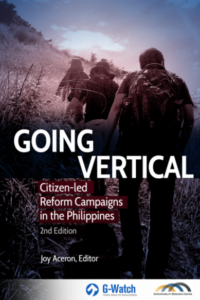Vertical Integration: Localizing the Concept
While it has been several decades since numerous transparency, participation and accountability (TPA) initiatives have been undertaken in development and governance around the world, the results have been mixed. There are TPA initiatives such as participatory mechanisms, access to information policies and accountability campaigns that worked, while many failed. The gains varied from simply functional, to instrumental, to transformational. Some solutions eventually became new problems requiring new solutions, which then led to innovations that sometimes distracted the reformers from fixing the basics.
There is now too much noise in the TPA field, despite the persistent problems of corruption, political abuse and government unresponsiveness. There is, therefore, a need to de-clutter and sift through the various approaches to determine not only which worked, and which did not, but also how, why and for whom.
The book Going Vertical: Citizen-Led Reform Campaigns in the Philippines (Aceron 2018) is our modest attempt to contribute to the growing body of knowledge, which asserts that more meaningful results are achieved using TPA solutions that employ strategic approaches. It argues that “pro-accountability initiatives achieve more substantial victories and gain better tangible results system-wide if the approaches they use are strategic, multi-level, and grounded on the actual power dynamics that are present in any accountability relationship” (Isaac and Aceron 2018, 230). This conclusion is based on Jonathan Fox’s earlier insight that “Strategic approaches to [social accountability]… bolster enabling environments for collective action, scale up citizen engagement beyond the local arena and attempt to bolster governmental capacity to respond to voice” (2014, 37).

One strategic approach to accountability is called vertical integration and our research examined how it enabled reform initiatives in the Philippines to gain meaningful results. Vertical integration is a strategic approach to citizen action for accountability. It is a strategy that involves a wide variety of actions and tactics by diverse and broad actors in engaging multiple levels of decision-making. As a guide to action, it “connects the dots” forming the needed scale to achieve lasting impact.
Our book studied seven citizen-led reform initiatives using the lens of vertical integration. These are:
- The campaign for agrarian reform in Bondoc Peninsula by the Katarungan/ RIGHTS Network.
- Social accountability in education through the Government Watch (G-Watch) Textbook Count Project.
- The campaign of Likhaan/ Reproductive Health Advocacy Network (RHAN) to enact the Reproductive Health Law (RH).
- The campaign of Buklod Tao, Center for Disaster Preparedness (CDP) and DRRNetPhils to enact the Disaster Risk and Reduction Management Law (DRRM Act).
- The anti-mining campaign of the Alternative Law Group (ALG) and Anislagan Bantay Kalikasan Task Force (ABAKATAF) in Placer, Surigao del Norte.
- The campaign to defend indigenous people’s rights by the Teduray-Lambaingan Women’s Organization (TLWOI).
- The campaign for housing and urban poor rights by the Damayan ng Maralitang Pilipinong Api (DAMPA).
This study is part of the efforts of G-Watch to do vertical integration by learning from other experiences and learning-by-doing. Our assumption is that we are able to better and collectively understand the strategy by demonstrating it in action. The idea is to find meaning from action itself, with the practices, analyses and reflections of G-Watchers themselves speaking of and demonstrating vertically-integrated action with actions at their level, contextualized in their own localities and coordinated to an overall overarching goal.
In communicating vertical integration, the uptake has been easy for campaigners. They repurposed existing terms or created new terms that can be popular because they resonate with already-existing common sense or everyday language.
For example, in a learning exchange organized by G-Watch, the issue of language was raised, with several participants asking how the concept of vertical integration can be made more accessible to ordinary Filipinos. We replied by narrating an incident during an earlier validation workshop with farmers from Bondoc Peninsula.
When the result of the study was shared to them, the farmers had an “Aha!” moment, prompting one of them to exclaim:
Oo nga! Ganyan ang ginagawa namin. Tapatan! Tinatapatan namin ang puwersa na ayaw sa pagpapatupad ng aming karapatan.
(Yes! That’s what we are doing. Confront! We confront the action and reaction of forces who are hindering our entitlements and rights.)
The use of tapatan here, if literally translated, means face-to-face, paralleling or matching, but the closest English expression for it would be ‘to confront with appropriate or needed response.’ This very common and practical Filipino word was used by the farmers to understand the complex term “vertical integration.” For the organized peasants of Bondoc Peninsula, vertical integration or tapatan is an accountability strategy that they are already employing in order to hold the powerful to account. Although it is not an exact translation of vertical integration, the word tapatan made it easier for the farmer-campaigners to understand the concept of vertical integration.
On the other hand, the members of DAMPA used a different term to explain vertical integration — tuhog-tuhog (skewer). They pointed out that the housing campaign entailed the need to tuhog (pierce through) various levels of decision-making in order to achieve significant gains.
These two examples of campaigners localizing vertical integration prove that as accountability concepts become embedded in practice, campaigners and activists themselves come up with the translation closest to them.
References
Aceron, Joy, ed. 2018. Going Vertical: Citizen-Led Reform Campaigns in the Philippines (Second Edition). Quezon City and Washington, DC: Government Watch and Accountability Research Center.
Fox, Jonathan. 2014. “Social Accountability: What Does the Evidence Really Say?” GPSA Discussion Paper 1. Washington, DC: The World Bank.
Isaac, Francis and Joy Aceron. 2018. “Synthesis: Lessons from vertically integrated reform campaigns in the Philippines,” in Going Vertical: Citizen-Led Reform Campaigns in the Philippines (Second Edition), edited by Joy Aceron. Quezon City and Washington, DC: Government Watch and Accountability Research Center.
For more on vertical integration, see the book co-published by G-Watch and ARC with multiple in depth case studies from various sectors and a synthesis chapter Going Vertical: Citizen-led Reform Campaigns in the Philippines.



